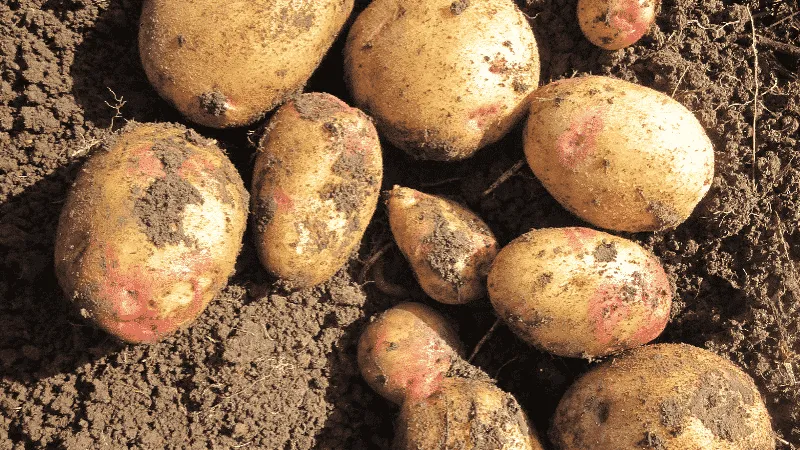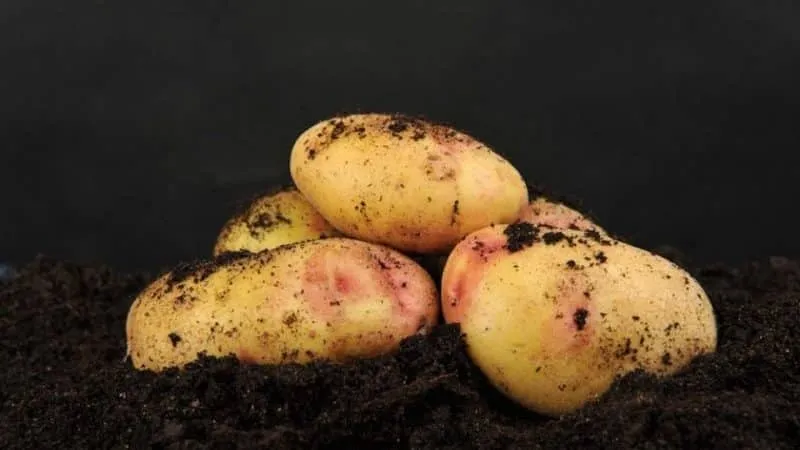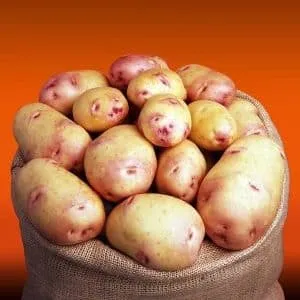The new Irish potato variety, Galaxy, has already gained popularity among vegetable growers due to its outstanding characteristics. This cultivar produces an early yield and has strong immunity to the dangerous potato disease, late blight. The plant adapts to various climatic conditions and forms no less than 10–14 tubers per bush. The potatoes have excellent taste and a long shelf life. Even an inexperienced gardener or farmer can successfully grow the Galaxy variety.
Table of contents
Potato Galaxy: Variety Description
The upright plant reaches a height of approximately 120 cm. The sturdy stems have slight ribbing and a smooth green surface. The bush produces branches up to 30 cm long. The pinnately dissected leaves are large, with a dark green colour. The flowers are purple with a yellow centre.

Origin and Development
The Galaxy potato variety is relatively new on the European market. The root vegetable was developed by Irish breeders. Initially, specialists aimed to create an early-maturing variety resistant to late blight, but they also paid attention to taste and storage duration. The cultivar passed all variety trials and was included in the EU Plant Variety Database in 2008.
Chemical Composition, Micronutrients, and Vitamins
Galaxy potatoes contain a high amount of starch—approximately 15–18%. The concentration of starch depends directly on the soil fertility where the vegetables are grown. On well-fertilised soils, starch levels will be higher.
Galaxy potatoes are classified as a dietary variety. The calorie content per 100 g of product is no more than 80 kcal. The tubers also contain a significant amount of organic acids, vitamins, carotenoids, and macro- and micronutrients. The fat content per 100 g is only 0.6%.
Ripening Period
The Galaxy potato is an early variety. The tubers fully mature 90 days after planting. This Irish potato has excellent taste, stable yield, and strong resistance to pests and most fungal diseases.
Yield
The tubers themselves are medium-sized. The standard weight of one potato is 90 g. Up to 13–14 tubers mature per plant. With proper care, farmers can harvest up to 300 quintals per hectare (on average, 250 q/ha).
Disease Resistance
Diseases to which the Galaxy variety is immune:
- Alternaria. A characteristic sign of infection is the appearance of dark brown or brown spots on the leaves, visible 2–3 weeks before flowering. In severe cases, the foliage yellows and falls off.
- Late blight. An infected plant can be distinguished by tiny but rapidly expanding brown spots on the leaves, which gradually spread to the stem. In dry weather, the affected plant dries out; in rainy conditions, it begins to rot.
- Potato wart. This fungal disease affects tubers, stems, and leaves. They become covered with wart-like growths, making the potatoes unsuitable for consumption—they quickly spoil and rot.
- Black scurf (Rhizoctonia). The most common symptom is sunken dark spots and net-like necrosis. The potato roots gradually rot, and the leaves fall off. In high humidity and clay soils, parasitic bacteria develop much faster.
Tuber Characteristics and Appearance
The potatoes have a round-oval shape. The smooth tubers are cream-coloured with a few pink eyes and small brown dots. The flesh is yellow and becomes fluffy when boiled.
Best Growing Regions
The Galaxy potato is suitable for cultivation in various climatic conditions. It is recommended for growing in Northern, Central, and Eastern Europe, but it is successfully cultivated in many other European countries.
Key Advantages and Disadvantages of the Variety

Advantages of the Galaxy variety:
- Stable yield;
- High marketability and excellent taste;
- Resistance to bacterial and viral diseases;
- Adaptability to different climates;
- Long storage life.
Disadvantages:
- Moderate resistance to common scab;
- At harvest time, not all foliage dries out, making it difficult to determine maturity.
How It Differs from Other Varieties
The Galaxy potato thrives and produces abundant yields in temperate climates. It is undemanding and forgiving of minor care mistakes.
Planting and Growing Features
To achieve a high-quality yield, it is essential to prepare the seed material correctly, choose the right planting time, and ensure proper watering and fertilisation.
Pre-Planting Preparation
Only healthy tubers should be selected for planting. Larger tubers retain more nutrients, promoting better root system development. Seed preparation involves several steps:
- Before planting, place the seed potatoes in a warm, sunny spot. The skin will harden and turn green, accelerating growth.
- UV rays sterilise the seeds, killing bacteria and fungal microorganisms.
- Choose tubers with sprouts up to 1 cm long—longer sprouts risk breaking during planting.
- Sprinkle the tubers with wood ash.
Soil Requirements
The crop prefers light sandy loam soil rich in organic fertilisers. In heavy soil, tubers develop slowly. In such cases:
- Add river sand to the soil.
- Incorporate organic matter during digging. If unavailable, use grass clippings, straw, or leftover plant residues from previous crops. This should be done during autumn ploughing, as spring fertilisation may not decompose in time.
Planting Time, Scheme, and Rules
Determining the exact planting time is challenging due to regional and climatic variations:
- Plant in warmed soil—otherwise, growth will be delayed. Seeds left in cold soil may fail entirely.
- In spring, till the soil a month before planting.
- Space rows 70 cm apart and plants 40 cm apart for easier maintenance and optimal tuber growth.
- Dig holes 15–20 cm deep.
- Add 100 g of chicken manure per hole as fertiliser.
- Place the seed potatoes and cover with soil, forming a small mound.
Traditionally, potato planting begins when birch buds start to open.
Growing Specifics
The Galaxy potato is successfully cultivated across most European regions. It is grown in home gardens for personal use and on farms for commercial sale. The cultivation technique is nearly identical to that of other potato varieties.
Care Tips
In hot weather, mulch the beds to retain soil moisture. Use straw, grass, or peat. Mulching also protects against sudden cold snaps.
Watering Schedule
The variety does not tolerate excessive watering and is prone to disease near water sources:
- After planting, use 1–2 litres of water per plant;
- In hot weather, water moderately—about 2 litres per plant;
- Drip irrigation can also be used with the same water volume.
Fertilisation
Feed the crop during the growing season. Use mineral fertilisers cautiously to avoid overdosing:
- In autumn, apply 5–7 kg of well-rotted manure and 15 g of potassium sulphate per m².
- In spring before planting, add half a bucket of peat manure or compost per m², along with 20 g of ammonium nitrate, 20 g of potassium sulphate, and 30 g of NPK fertiliser per m².
- During growth, before earthing up, apply a solution of 0.5 buckets of water and chicken manure (1:10 ratio) per m², followed by thorough watering.
Weeding and Hilling
Hilling—mounding soil around the plant stems—serves several purposes:
- Prevents stems from lying on the ground;
- Improves soil aeration;
- Suppresses weeds.
Hilling increases yield. Perform it twice per season: when plants reach 20–25 cm and again 2–3 weeks later.
Note: A third hilling may be needed if rain or watering washes away soil, exposing roots.
If soil temperature exceeds +25°C and air temperature is above +30°C, avoid hilling. Instead, loosen the soil and remove weeds.
Disease and Pest Control
The Galaxy potato may be affected by the following diseases and pests:
- Common scab. Symptoms include shallow, concave, net-like, or raised lesions on tubers. The disease affects both skin and flesh. Treat with Fitosporin-M (apply 3 times during the growing season—mix one sachet in 3 L water or follow instructions). Alternatively, use Cuproxat (25 g per 10 L water). Repeat after 10 days, but no later than 20 days before harvest.
- Stem nematode. These 1-mm-long worms infest stems and tubers. Infected potatoes show tiny dark spots on the skin. Severe cases lead to cracked skin and dry rot. Nematodes thrive in moist conditions. Treat with Basudin.
- Wireworm. The larvae of click beetles are yellow-brown, 2–3 cm long, with a hard shell. Adults are black, elongated beetles up to 5 cm long. Control with nitrogen-based fertilisers: ammonium sulphate (30 g/m²), ammonium nitrate (20 g/m²), or ammonium chloride (30 g/m²). The strong ammonia smell repels them. Alternatively, use Actara—dissolve 1 g in 10 L water for pre-planting treatment or apply dry powder to planting holes.
- Colorado potato beetle. The pest feeds on potato foliage and tubers, especially in spring when shoots are not yet visible. Use traps with potato pieces as bait. Spray plants with a urea solution (100 g per 10 L water) in the morning or evening. Many growers use Confidor (follow instructions).
To deter pests, add onion peels, wood ash, or mustard powder to planting holes.
Harvesting and Storage
The potatoes fully mature 90 days after planting. This is the main harvest indicator, as Galaxy’s foliage does not dry out beforehand.
When and How to Harvest
To check maturity, dig up one plant first. If the skin is firm, proceed with harvesting:
- Dig up potatoes with a spade or mechanical equipment (tiller, harvester).
- Before bagging, dry tubers in sunlight for no more than 2 hours. Prolonged exposure increases toxic solanine production.
- Discard damaged tubers and sort seed potatoes.
Storage Specifics and Shelf Life

After harvesting, store the crop in crates in a dry, cool place (e.g., a cellar). After 4 weeks, sort the potatoes again and discard spoiled ones.
In a cellar with up to 80% humidity, the tubers keep for 7 months. They are resistant to damage, making them ideal for long-distance transport.
Potential Growing Challenges
Many rural growers plant potatoes in the same spot for 10–15 consecutive years. Small plots make crop rotation difficult. However, there is a simple solution.
Whenever possible, obtain new seed potatoes or exchange planting material with neighbours. Each seed potato performs better in a new location.
Tips from Experienced Growers
Spring planting recommendations:
- Plant medium-sized tubers or cut large ones, ensuring each piece has several eyes.
- Deep planting results in small tubers and excessive foliage.
- Chemical fertilisers are preferable—organic matter (especially manure) can impair flavour.
- For larger, tastier tubers, slightly bend the stems 1–2 weeks after flowering. This redirects nutrients to tuber growth.
- If leaves blacken from late blight, remove and burn affected parts immediately.
- Plant horseradish, marigolds, or aromatic herbs along field edges—they promote plant health.
- Deter Colorado beetles with coriander, catmint, nasturtium, tansy, or marigolds planted nearby.
- Sunflowers inhibit potato growth.
Galaxy Variety Reviews
Experienced growers generally praise the Galaxy variety. It performs well in most European regions.
Thomas, Germany: “I’ve grown potatoes for years and love experimenting with new varieties. I tried Galaxy a few seasons ago—excellent taste and storage. Highly recommended!”
Sophie, France: “I chose Galaxy for its yield and hardiness. The tubers are large (80–90 g), disease-free so far. I control beetles with pesticides. The potatoes keep well until spring and taste fantastic. I even took photos to recommend it to neighbours—will definitely replant!”
Conclusion
Even beginners can grow Galaxy potatoes successfully. However, don’t rely solely on its hardiness—proper care ensures the best results. With good agricultural practices, Galaxy rewards growers with a bountiful, delicious harvest.







